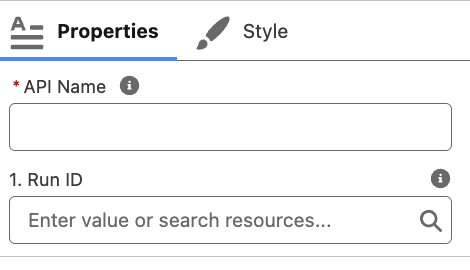SimpleT AI Async Response Awaiter
SimpleT AI Async Response Awaiter is a specialized Flow action that checks the status of running AI processing jobs and retrieves results when they're complete. This tool enables you to create sophisticated workflows that don't get blocked by complex AI operations.
What This Tool Does
Primary Functions
- Status Checking: Checks if your async AI processing is complete
- Result Retrieval: Gets the final AI results when processing is done
- Progress Monitoring: Tells you if AI is still working or finished
- Error Detection: Identifies when AI processing has failed
How Async AI Processing Works
The Two-Step Process
Step 1: Start AI Processing (Async)
Action: SimpleT AI Service
- Execute Async: true
- Result: You get a Run ID and Thread ID (job tracking numbers)
Step 2: Check for Results (This Tool)
Action: SimpleT AI Async Response Awaiter
- Input: Run ID from Step 1
- Result: Either "No Content" (still processing) or final AI results
Action: SimpleT AI Service
- Execute Async: true
- Result: You get a Run ID and Thread ID (job tracking numbers)
Step 2: Check for Results (This Tool)
Action: SimpleT AI Async Response Awaiter
- Input: Run ID from Step 1
- Result: Either "No Content" (still processing) or final AI results
Status Responses Explained
- "No Content": AI is still working - check again later
- Actual Results: AI finished - here's your final response
- Error Message: Something went wrong - processing failed

Common Patterns and Templates
Pattern 1: Simple Polling Loop
Variables: asyncJob, statusResult, attemptCount, maxAttempts
Loop:
1. Wait: {!pollingInterval} minutes
2. Action: SimpleT AI Async Response Awaiter
3. Decision: Complete? → Process / Continue polling
4. Increment: attemptCount
5. Check: Max attempts → Timeout handling / Continue
Loop:
1. Wait: {!pollingInterval} minutes
2. Action: SimpleT AI Async Response Awaiter
3. Decision: Complete? → Process / Continue polling
4. Increment: attemptCount
5. Check: Max attempts → Timeout handling / Continue
Pattern 2: Progressive Polling
Variables: waitTime (starts small), maxWait, multiplier
Loop:
1. Wait: {!waitTime} minutes
2. Check Status
3. If not complete: waitTime = MIN(waitTime * multiplier, maxWait)
4. Continue
Loop:
1. Wait: {!waitTime} minutes
2. Check Status
3. If not complete: waitTime = MIN(waitTime * multiplier, maxWait)
4. Continue
Troubleshooting
Common Issues and Solutions
Processing Never Completes
Possible Causes:
• AI processing failed but not returning error
• Network connectivity issues
• Service overload
Solutions:
• Set maximum processing time limits
• Implement manual intervention paths
• Add administrator notifications
• Create fallback processes
Possible Causes:
• AI processing failed but not returning error
• Network connectivity issues
• Service overload
Solutions:
• Set maximum processing time limits
• Implement manual intervention paths
• Add administrator notifications
• Create fallback processes
Getting Help
• Flow Debug: Use debug mode to trace async processing
• Error Logs: Check fault path variables for error details
• Administrator: Contact admin for service status and configuration
• Support: Provide Run ID and Thread ID when reporting issues
• Error Logs: Check fault path variables for error details
• Administrator: Contact admin for service status and configuration
• Support: Provide Run ID and Thread ID when reporting issues